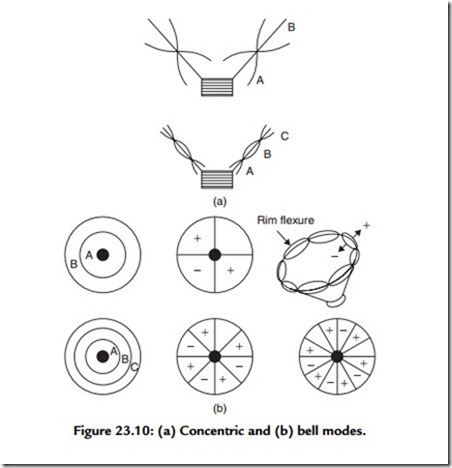Straight-Sided Cones
The most important parameter affecting the performance of a loudspeaker is “cone flexure.” Because real materials are not infinitely rigid and have mass, the velocity of propagation through the material is finite. The cone is driven at the apex and the impulse travels outward toward the periphery where it is reflected back to the source. At particular frequencies when the distance to the edge are odd quarter wavelengths, the returning impulse will be 180° out of phase and tend to cancel; conversely, when the distance is multiples of half wavelengths they will augment—under these conditions the system can be considered as a transmission line, and theoretically (and to some extent, practically), if the outer annulus were made resistive and of the correct value, the line would be terminated and no reflections would occur [see Figure 23.10(a)].
The conical diaphragm also has radial or “bell” modes of flexure. These are similar to the resonances in a bell and occur when the circumference is an integral number of wavelengths [see Figure 23.10(b)].
Obviously, both modes occur simultaneously, and at some frequencies reinforce each other and at others tend to cancel. Their main effects on performance are the “wiggles” on the response curve and transient and delay distortions. It is instructive to apply a short “tone burst”; it will be seen that at particular frequencies during the duration of the input signal the diaphragm is stationary and on cessation of the pulse it will burst into oscillation at some frequency unrelated to the driving current.
The art of diaphragm design is to minimize these deleterious effects. One method is to introduce concentric corrugations; the effect is to increase the stiffness seen by the bell modes and decrease stiffness for the concentric modes. By correctly proportioning the number, width, and wall thickness of these corrugations, the outer edges of the cone are progressively decoupled as frequency increases. This results in the “working” diameter of the diaphragm being reduced at high frequencies, thus improving the high-frequency performance.
